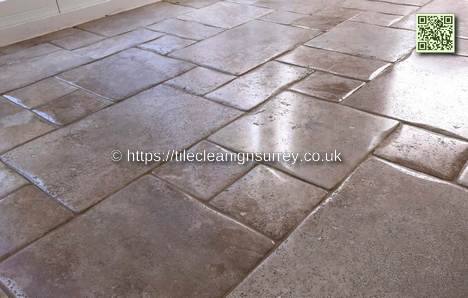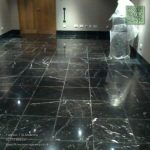This case study showcases the restoration of travertine tiles in high-traffic areas of a property in Chessington, Surrey. As the years passed, the once-beautiful travertine had lost its luster, becoming dull, stained, and worn. To restore its original elegance, we undertook a comprehensive project that included deep cleaning, filling natural holes, and applying a protective sealant. The result was a beautifully revitalized, low-maintenance floor that regained its natural charm and received long-lasting protection for future durability.
Travertine Floor Cleaning In Chessington – Key Points
- Thorough Cleaning is Crucial: A rotary scrubbing machine, heavy-duty travertine cleaners, and hot water pressurized rinse equipment remove ingrained soil that regular mopping can’t tackle.
- Filling Holes Enhances Appearance and Durability: Addressing natural holes in the travertine improves its look and prevents future damage, ensuring the stone’s longevity.
- Sealing Simplifies Maintenance: A properly applied sealer acts as a protective barrier, making future cleaning easier and preventing stains from setting in.
- Consistent Maintenance is Essential: A regular maintenance routine, including periodic resealing, keeps the travertine pristine and preserves its beauty for years.
Client Background:
This project focused on restoring travertine tiles in a Chessington home, where the kitchen, hallway, and w/c floors had suffered significant wear over the years. The homeowner sought a solution to bring back the natural beauty of the travertine while ensuring the floors would be easy to maintain and durable enough to withstand daily use. The restoration process involved deep cleaning, filling natural holes, and applying a protective sealant to achieve a clean, resilient surface that highlights the rich colors of the travertine.
 Project Background:
Project Background:
The travertine tiles, admired for their natural beauty and durability, had been in place for over a decade. Over time, the tiles lost their smooth finish, with soil accumulating in the pits and voids. The grout was discoloured, diminishing the floor’s overall look. The project involved deep cleaning the tiles, filling the natural holes, and applying a protective sealer to restore the floor’s appearance and enhance its long-term resilience.
Challenges Encountered During the Project
- Deeply Embedded Dirt: Years of foot traffic had caused dirt to become ingrained in the natural pits and voids of the travertine, making it difficult to clean with standard methods.
- Natural Holes: Travertine tiles’ inherent holes and gaps trap the dirt and add to the floor’s worn appearance.
- Stained Grout: Over time, the grout between the tiles had become heavily stained, further diminishing the floor’s visual appeal.
- High Traffic Areas: The constant use of these spaces required a restoration approach that effectively revitalized the floor while minimizing disruption to the household.
Solution and Process:
Step 1: Assessment and Planning
The initial assessment identified the level of soiling and wear on the travertine tiles. Based on these findings, a plan was crafted to remove the ingrained dirt, fill the natural holes, and apply a protective sealer to restore the tiles and improve their durability.
Step 2: Cleaning Process
We prepared the work area by removing small pieces of furniture and clearing loose debris with brushing and vacuuming. After applying a diluted travertine cleaner and letting it soak for ten minutes, we used a rotary scrubbing machine with a medium-grade brush to remove the surface soil. We used hot-water rinse and capture equipment to tackle the dirt trapped in the holes and pits, effectively lifting the remaining soils and restoring the travertine’s clean surface.
Step 3: Filling Natural Holes
Step 4: Sealing the Floor
We applied a hybrid satin finish sealer with a roller, creating a mid-sheen look. This sealant formed a protective barrier against stains and dirt, making the floor easier to maintain. We ensured full coverage and a consistent finish during the sealing process.
Project Timeline:
We completed the project in two days, from assessment to final touches.
Project Results:
We restored the travertine to its original finish by removing ingrained soil and stains, revealing the natural colours of the tiles. The client expressed her delight with the results, commenting that the floor “looked as good as new”. The protective sealer now keeps the travertine low-maintenance and durable, preserving its beauty and functionality for the long term. This project turned a dull, worn floor into a revitalized, stunning surface.
Conclusion:
This travertine cleaning project in Chessington restored the tiles’ natural beauty, making them a durable and low-maintenance flooring solution for the homeowner. We significantly enhanced the floor’s appearance and extended its longevity through deep cleaning, precise filling, and effective sealing. This case study highlights the value of professional cleaning and maintenance for natural stone surfaces like travertine.
If your travertine floor needs cleaning or restoration, contact us today for a consultation. Our expert services will keep your natural stone surfaces beautiful and functional for years to come.
Frequently Asked Questions
How Long Does the Travertine Cleaning Process Take?
The travertine cleaning usually takes several hours, depending on the floor’s condition. Thorough cleaning techniques remove ingrained soil and prepare the tiles for sealing, which helps prolong their lifespan.
Is It Safe to Use DIY Cleaning Products on Travertine?
Homemade cleaning solutions on travertine can be risky due to potential chemical reactions that may harm the stone. For this reason, it’s safer to use pH-balanced cleaners specifically designed for natural stone to ensure effective and safe cleaning.
Can Travertine Floors Be Installed Over Existing Tile?
Yes, travertine floors can be installed over existing tiles. Proper installation requires assessing the underlying surface and potentially levelling it to ensure a stable, long-lasting finish.
What Is the Cost Range for Travertine Floor Cleaning Services?
The cost of travertine floor cleaning services typically ranges from £3 to £5 per square foot. The price varies depending on the cleaning methods, soiling, and the condition of the tiles.
How Often Should Travertine Floors Be Professionally Cleaned?
Travertine floors should be professionally cleaned every 12 to 18 months. Regular maintenance, including prompt spill management and periodic sealing, will help preserve the stone’s natural beauty and longevity.
The post Travertine Floor Cleaning In Chessington Surrey. Sponsored by: Travertine Cleaning Chessington
The Article Reviving Travertine Floors in Chessington, Surrey appeared first on https://fabritec.org
The Article Reviving Travertine Floors in Chessington, Surrey Was Found On https://limitsofstrategy.com



Reading about the restoration of travertine tiles in Chessington truly resonates with me, particularly because I can appreciate how natural stone can drastically transform a space. It’s interesting to see how these types of restorations not only breathe new life into the aesthetics of our homes but also highlight the importance of maintenance and care for our interiors.
I completely agree with you about the impact of natural stone like travertine. There’s something inherently calming and grounding about it, isn’t there? When it’s well maintained, it can really elevate the feel of a space, making it more inviting and warm. I’ve seen how proper care can actually enhance the natural beauty of these materials over time, which is quite fascinating.
I feel the same way about natural stone like travertine—there’s definitely a unique quality to it that brings a sense of calm to a space. It’s interesting how these materials seem to connect us to nature, almost like they carry the stories of the earth within them. When well taken care of, they truly transform an area into a warm sanctuary.
Speaking of enhancing the natural beauty of our spaces, I recently came across some insights about how professional house cleaning can really transform a home in Pennsylvania, making it feel even more warm and inviting over time.
‘The benefits of professional house cleaning in Pennsylvania.’
https://writebuff.com/the-benefits-of-professional-house-cleaning-in-pennsylvania/.
It’s so true—there’s something special about the feel of natural stone like travertine. It really does have this warm vibe that makes a space feel like home. I’ve noticed that with the right maintenance, not only does it keep its beauty, but the texture and color can really transform over time. It’s like watching a piece of art develop.
It’s fascinating how natural stone, like travertine, can really alter the feel of a space. I completely agree with you on the significance of maintenance—it’s like our homes are living entities that require our attention to truly thrive. I remember when I had some marble tiles in my kitchen that had lost their luster over the years. Once I learned to properly care for them, it felt like I had a brand-new space.
The transformation of travertine tiles in this case study is a fascinating glimpse into how restoration can breathe new life into materials that have significant aesthetic and emotional value. It’s interesting to consider how often we overlook the beauty of the surfaces we walk upon daily, taking for granted that they, too, need care and attention to maintain their appeal. Your thorough approach to cleaning, filling, and sealing embodies a philosophy that goes beyond mere maintenance; it reflects a deep respect for the craftsmanship and natural beauty that stone features can bring into our lives.
I appreciate your insights on the restoration process of travertine tiles. There’s something quite profound about how our surroundings can reflect not only style but also our values in craftsmanship and sustainability. It’s true that we often overlook the beauty of surfaces we engage with daily, whether it’s the tiles underfoot or the counters we prep our meals on.
You’ve touched on something truly essential about our relationship with our environment. The tactile experiences we have with everyday surfaces—like the travertine tiles that often go unnoticed—can carry messages about who we are and how we choose to honor the places we inhabit. The craftsmanship behind those tiles, whether they’re newly installed or restored with care, speaks to a level of detail that so many appreciate but might not always acknowledge in their daily lives.
I completely resonate with your perspective on the significance of restoration in revitalizing materials like travertine. It’s remarkable how these surfaces can carry sentiments of history and craftsmanship, yet often go unnoticed amidst our daily routines. I think it speaks to a larger societal tendency to overlook the beauty in our surroundings, especially in spaces we inhabit regularly.
If you’re intrigued by the idea of restoring beautiful surfaces and preserving their inherent charm, I think you’ll find this case study on travertine floors in Chertsey quite enlightening.
‘Cleaning and Sealing a Travertine Floor in Chertsey, Surrey’
https://writebuff.com/cleaning-and-sealing-a-travertine-floor-in-chertsey-surrey/.
It’s fascinating to see how a focused restoration process can completely transform travertine tiles that have endured the wear and tear of high-traffic areas. The thorough cleaning techniques you described highlight a crucial aspect of stone care that many property owners often overlook. I’ve encountered similar situations in my own experiences, where tiles in busy environments seemed beyond saving.
It’s interesting to hear how your own experiences resonate with the challenges of maintaining travertine tiles. Many people underestimate how much wear and tear these surfaces can take before they feel like a lost cause. The cleaning techniques really are just the starting point—it’s about understanding the stone itself and knowing how to work with its unique characteristics.
It’s great to hear that you’ve had similar experiences. There’s something really rewarding about bringing old tiles back to life, especially when they seem like they’ve reached the end of the line. The beauty of travertine is that, with the right approach, it can regain its character and shine, even in busy spaces.
I totally relate to your experience. It’s easy to underestimate the potential of surfaces that have been neglected for a while, especially in high-traffic areas. In my own encounters with travertine tiles, I’ve noticed that the transformation often brings out the original character of the stone, which can be surprisingly beautiful.
The restoration of travertine tiles in high-traffic areas, as highlighted in your case study, truly exemplifies the profound impact that proper care and maintenance can have on stone surfaces. It’s fascinating to consider how materials like travertine, while celebrated for their timeless beauty and durability, can also suffer significantly from neglect, especially in busy areas where they receive consistent wear and tear.
You bring up an interesting point about the balance between beauty and care in materials like travertine. It’s true that while these stones can add a certain elegance to a space, they also require a mindful approach to maintenance, especially in areas that see a lot of foot traffic. I’ve always found it fascinating how the aesthetic quality of natural materials can change over time based on how we care for them—or neglect them.
I recently came across a detailed piece on cleaning and sealing travertine floors that really emphasizes how thoughtful maintenance can extend the life and beauty of these surfaces, especially in bustling spaces.
‘Cleaning and Sealing a Travertine Floor in Chertsey, Surrey’
https://writebuff.com/cleaning-and-sealing-a-travertine-floor-in-chertsey-surrey/.
You’ve touched on an essential aspect of working with natural materials like travertine. It’s true that their beauty can really transform a space, but it comes with the responsibility of proper care. Over time, the way we maintain these surfaces has a profound influence on their appearance and durability.
You’ve hit the nail on the head with your thoughts on the balance between beauty and care when it comes to travertine. It’s remarkable how this natural stone can transform a space. However, the way a floor develops over time really does hinge on how we look after it.
You’ve touched on such an important aspect of stone care! It’s easy to overlook how day-to-day activities can really take a toll on beautiful materials like travertine. I’ve encountered so many spaces where these stunning tiles have lost their luster simply because they’ve been neglected in high-traffic zones.
You’re spot on about the significance of proper care and maintenance for travertine tiles. It’s interesting how, despite their resilience, these materials can really start to show their age without the right attention. In high-traffic areas, it’s almost like they tell a story—every scuff and stain a reminder of the countless feet that have passed over them.
It’s interesting how just as we maintain stone surfaces to preserve their beauty, choosing the right SEO company can significantly impact the longevity and visibility of your business online.
‘Which SEO Company Do You Choose For Your Business?’
https://writebuff.com/which-seo-company-do-you-choose-for-your-business/.
You make a great point about travertine tiles reflecting a sort of history through their wear and tear. It’s fascinating how materials can tell stories, almost like they have a character of their own. I think the same kind of narrative can be seen in businesses too—every decision and strategy shapes their journey and how they’re perceived by the world.
You bring up such an interesting perspective on travertine tiles and their narrative quality. It’s true that materials have a way of absorbing moments in time. I often find myself reflecting on how the wear and tear of objects can mirror our own experiences—how each scratch, stain, or blemish tells a story.
I appreciate your thoughts on storytelling through materials; it reminds me of the journey we take in crafting online courses—each tool and decision shapes our unique offering and its impact on learners.
‘Tools and Software Required to Create and Sell Online Courses’
https://writebuff.com/tools-and-software-required-to-create-and-sell-online-courses/.
You touched on something beautiful about the connection between our physical surroundings and personal experiences. It’s fascinating to think of wear and tear as a language—a narrative written on surfaces and objects that reflects our journeys. Each mark carries a memory, a moment, and knowing that travertine tiles can tell stories in such a tactile way makes their presence in a home feel richer.
You’ve captured a vital aspect of working with natural stone, particularly travertine. The way these materials can transform from stunning to worn under the strain of daily life is a poignant reminder of the balance between beauty and care. When I first delved into this case study, I was struck by how the atmosphere of an environment can be so deeply influenced by the surfaces we walk on.